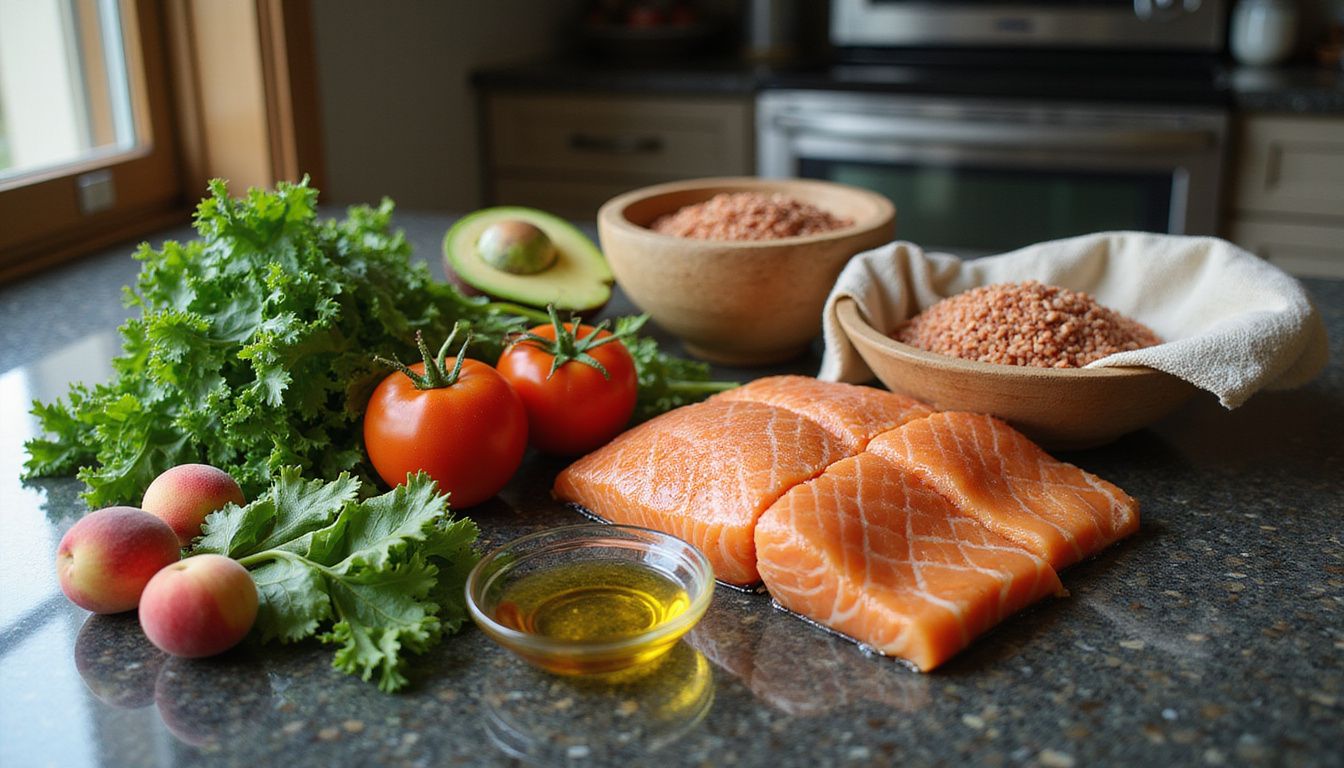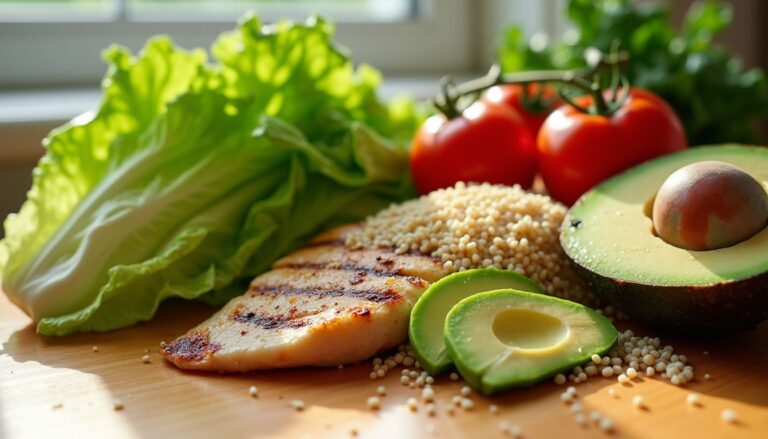2000 Calorie Meal Plan: Sample Menus For Losing Weight With A Balanced Diet
Our Nutrition Assistant AI Suite will transform your body. You will lose fat, get toned, and build muscle. Gain confidence and optimal health.
Healthy eating feels confusing when meals are not balanced and calories are unclear. I have felt that same stress. A simple 2000 calorie meal plan helped me find steady energy, better focus, and an easier path to lose weight without guesswork.
After studying federal nutrition guidance and trying different menus, I built steps that work in real life. In this guide, I explain what a balanced 2000 calorie day looks like, which foods to include, foods to limit, sample menus, and tips that make meal prep simple. If you want clear rules with room for taste, keep reading.
Key Takeaways
- A 2000 calorie meal plan is a common benchmark for adults, and it can support gradual weight loss of about one pound per week as a rule of thumb using the 3,500 calorie deficit estimate (USDA Dietary Guidelines).
- Balanced days include lean protein, whole grains, fruits, vegetables that deliver about 25 to 30 grams of fiber per day, and healthy fats like olive oil, avocado, or nuts.
- Portion guidance is simple: aim for meals near 500 calories and snacks near 200 to 300 calories, which aligns with MyPlate style planning.
- Limit processed foods high in added sugar or sodium, such as soda, candy, and refined carbs, since frequent intake raises obesity and heart disease risk (CDC and American Heart Association).
- Calorie and nutrient needs vary with age, sex, and activity. If you have medical conditions or special nutrition needs, work with a registered dietitian for a personalized plan.

What is a 2000-Calorie Meal Plan?

A 2000 calorie meal plan sets a daily energy goal that many adults can use for maintenance or weight loss. I like it because it gives me structure without feeling rigid. Meals and snacks add up to about 2,000 calories, and I can adjust portions if my activity changes.
What does a 2000-calorie meal plan mean?
It means you plan all meals and snacks to total about 2,000 calories per day. The Dietary Guidelines for Americans use 2,000 calories as a reference point for adults, although real needs vary by size, age, and movement.
Nutrition Facts labels use a 2,000 calorie base to display Percent Daily Value. That makes it easier to compare foods. When I started strength training, I used this level to fuel workouts while keeping body fat in check. I focused on lean protein, whole grains, and vegetables to help me stay full.
Many adults can plan around 2,000 calories per day, which aligns with the USDA Dietary Guidelines reference pattern.
Why is a 2000-calorie plan important for weight loss and balanced nutrition?
It gives a clear target that helps create a calorie deficit. For example, someone who usually eats 2,500 calories may lose weight by moving down to 2,000. Results vary, but slow loss is more sustainable and easier to maintain.
A set calorie level also keeps portions and nutrients in balance. I can plan protein, fiber, and healthy fats on purpose, not by accident. That structure makes room for favorite foods in smart amounts while keeping added sugar and extra sodium low.
Benefits of a 2000-Calorie Diet
Using a 2000 calorie target helps me manage intake, cut mindless snacking, and keep energy steady. I find workouts feel better, and I recover faster, when my meals are balanced and planned.
How does a 2000-calorie diet promote gradual and sustainable weight loss?
Weight loss needs a calorie gap. Trimming about 500 calories per day from maintenance levels often supports a slow drop in body weight. Many people see about one pound lost per week on average. That pace is easier on mood and muscle.
Protein keeps me full, and fiber from vegetables and whole grains slows digestion. Together with regular movement, this plan helps reduce fat while protecting lean muscle. It also keeps hunger spikes from derailing my progress.
Small, steady changes add up. Quick fixes fade fast.
What balanced nutrition benefits come from a 2000-calorie diet?
This plan makes room for a full spread of nutrients. I aim for at least 65 grams of protein a day, often more if I train hard. I target 25 to 30 grams of fiber from produce, beans, and whole grains to support fullness and gut health.
Choosing mostly unprocessed foods helps me hit key vitamins and minerals like calcium and potassium. I build my day around a protein-rich breakfast, plenty of vegetables, whole grains, fruit, and yogurt or milk. I feel satisfied, not stuffed.
How does this diet help control portion sizes and calorie intake?
Dividing the day into three meals near 500 calories and one or two snacks near 200 to 300 calories removes guesswork. I use MyPlate as a simple visual: half plate vegetables and fruit, one quarter grains, one quarter protein, plus healthy fats in small amounts.
Cooking at home makes it easier to measure. I use measuring cups for rice and oats, and I portion sauces and dressings to lower added sugars and salt. Clear portions help me stay consistent, even during busy weeks.
Key Components of a 2000-Calorie Meal Plan
I build each day from core pieces: lean protein, healthy fats, whole grains, colorful produce, and dairy or dairy alternatives. These parts help me reach 2,000 calories with balance and taste.
Protein-rich foods
Protein supports fullness and muscle repair. I rotate poultry, seafood, eggs, beans, lentils, tofu, and tempeh. These options fit most budgets and cooking styles.
- Animal sources: skinless chicken, turkey, lean beef, fish, shellfish, eggs
- Plant sources: beans, lentils, soy foods like tofu or tempeh, pea or soy protein powder
Most adults do well with at least 65 grams per day. Larger bodies or intense training may need more. I spread protein across meals to curb hunger and support recovery.
Healthy fats
Healthy fats help with vitamin absorption and heart health. I use olive oil for cooking and dressings, and I add avocado, nuts, seeds, and natural nut butters for flavor and texture.
- Oils: olive, avocado
- Nuts and seeds: almonds, cashews, walnuts, sunflower seeds, flaxseed
Fats are calorie dense, so I portion them with care. A small handful of nuts or a tablespoon of oil can go a long way in a 2000 calorie day.
Whole grains and complex carbohydrates
Whole grains digest slowly and help control appetite. I choose oats, brown rice, quinoa, bulgur, or whole wheat pasta. These carbs fuel workouts and daily movement without sharp blood sugar spikes.
Grains also carry fiber, B vitamins, and minerals that support metabolism and gut health. I usually aim for 6 ounce equivalents per day, which might look like oatmeal at breakfast and brown rice at dinner.
Fruits and vegetables
Produce adds vitamins, minerals, and fiber for very few calories. I mix non-starchy vegetables, like leafy greens and peppers, with some starchy choices, like potatoes or sweet potatoes, for longer-lasting energy.
- Fruits: berries, apples, citrus, melon, bananas, grapes
- Vegetables: spinach, kale, tomatoes, broccoli, cauliflower, zucchini, peppers
Color is a quick signal. More colors usually mean more nutrients. I try to include at least one fruit and two vegetables at both lunch and dinner.
Low-fat dairy options
Dairy or fortified alternatives supply calcium and protein with fewer calories. MyPlate suggests about 3 cups per day in a 2,000 calorie pattern. That could be milk, yogurt, kefir, or cheese in measured portions.
If I use dairy alternatives, I look for unsweetened versions with calcium and vitamin D added. That keeps sugar low while meeting bone health needs.
Foods to Include in a 2000-Calorie Diet
I focus on foods that deliver protein, fiber, and key nutrients without a lot of added sugar or salt. This list keeps my meals satisfying and supports weight loss goals.
Which high-protein foods are best for a 2000-calorie diet?
Lean meats, poultry, fish, eggs, legumes, soy foods, and yogurt are top choices. They offer essential amino acids, the building blocks of muscle, and help control hunger.
- Lean animal protein: chicken breast, turkey, lean beef, fish, eggs
- Plant protein: lentils, black beans, chickpeas, tofu, tempeh, edamame
- Convenient options: Greek yogurt, cottage cheese, protein powder for smoothies
High protein meals increase the energy the body uses during digestion, called the thermic effect. That can help support slow and steady weight loss alongside regular activity.
What are the best fiber-rich vegetables to include?
Non-starchy vegetables are low in calories and high in volume, which helps with fullness. I load up on leafy greens, tomatoes, broccoli, cauliflower, zucchini, and peppers.
- Non-starchy: spinach, kale, tomatoes, broccoli, cauliflower, peppers, zucchini
- Starchy: sweet potatoes, potatoes, peas, winter squash
Adults should aim for about 25 to 30 grams of fiber per day. I hit that target by pairing vegetables with beans, whole grains, fruit, and nuts.
Which whole grains support a balanced 2000-calorie diet?
Oats, brown rice, quinoa, bulgur, farro, and whole wheat breads fit well. The MyPlate plan suggests about 6 ounce equivalents of grains per day, with at least half from whole grains.
I often start with oatmeal for breakfast and swap white rice for quinoa or brown rice at dinner. These swaps keep energy steady and reduce cravings later at night.
What healthy fats should be included?
Choose fats that promote heart health. I cook with olive oil, add avocado to bowls or sandwiches, and use nuts or seeds as toppers for salads and yogurt.
- Oils: olive, avocado
- Plant fats: avocado, olives
- Nuts and seeds: almonds, cashews, walnuts, sunflower seeds, flaxseed, chia
These foods help meals taste delicious while supporting vitamin absorption. Small amounts are enough because fats are calorie dense.
Why choose low-sodium condiments and spices?
High sodium intake can raise blood pressure. Most adults should stay under 2,300 milligrams of sodium per day. Many packaged sauces and dressings push me past that limit without warning.
I season with herbs and spices like garlic, ginger, paprika, cumin, and pepper. Fresh lemon, vinegar, and chili flakes add brightness without extra salt. Flavor stays high while sodium stays reasonable.
Foods to Avoid on a 2000-Calorie Plan
Some foods work against weight loss and balanced nutrition. I limit choices that pack a lot of calories, added sugars, or sodium into small portions.
What processed and sugary snacks should be avoided?
Sweets and ultra-processed snacks make it harder to stay within calories. Candy, pastries, ice cream, and many “diet” treats can be loaded with added sugar. They can crowd out nutritious foods and trigger cravings later.
Public health data show that high intake of added sugar links to weight gain and heart risk. I keep desserts as planned treats, and I choose fruit or yogurt for daily sweets.
Why avoid refined carbohydrates?
Refined grains like white bread, standard pasta, and many cereals digest fast and cause sharp blood sugar swings. This can lead to hunger soon after eating and can make portions harder to control.
When I swap in whole grains, I feel fuller longer. I also get more fiber, which supports gut health and a calmer appetite through the day.
How do sweetened beverages affect this diet?
Sodas, sugary coffee drinks, sports drinks, and fruit punches can add hundreds of calories without filling me up. A single can of soda has about 150 calories and more than 35 grams of sugar.
Liquid calories do not register well with hunger signals. Cutting these drinks helped me reduce daily calories while keeping food quality high.
Which high-sodium and fried foods should be limited?
Fast-food fries, pizza, processed meats, and breaded fried items tend to be high in sodium and saturated fat. They are calorie dense, and the portions look smaller than the calories suggest.
I choose baked or grilled versions whenever possible. Simple swaps, like roasted potatoes instead of fries, save calories and improve heart health markers over time.
Sample 3-Day 2000-Calorie Meal Plan
Here is a practical example for three days. Portions can be adjusted to match your needs. I use these menus as a template, then swap in similar foods to keep variety high.
What does Day 1’s meal plan look like?
Breakfast: Vegetable omelet with 2 eggs, 1 cup spinach, 1/4 cup mushrooms, 1/4 cup broccoli, plus 1 cup sautéed sweet potatoes cooked in 1 tablespoon olive oil.
Snack: 1 medium apple with 2 tablespoons peanut butter.
Lunch: Mediterranean tuna pita: 1 whole wheat pita filled with 5 ounces canned tuna, chopped red onion and celery, 1/4 avocado, and 1 tablespoon feta.
Snack: 2 ounces cheddar with 1 cup grapes.
Dinner: 5 ounces baked salmon with 2 teaspoons olive oil, 1/2 cup wild rice, and 1 cup each roasted asparagus and eggplant.
This day balances protein, fiber, and healthy fats for steady energy near 2,000 calories.
What meals are included on Day 2?
Breakfast: 2 slices whole grain toast with 2 tablespoons almond butter, 1 banana, and cinnamon.
Snack: Smoothie made with 3/4 cup unsweetened milk, 1 cup spinach, 1 scoop plant protein powder, 1 cup blueberries, and 1 tablespoon hemp seeds.
Lunch: Avocado tuna salad over 2 cups leafy greens with 1/2 avocado, 5 ounces tuna, 1/2 cup cherry tomatoes, and lemon vinaigrette.
Alternate lunch option: Black bean and sweet potato burrito: 1 whole wheat tortilla filled with 1/4 cup brown rice, 1/2 cup cooked sweet potato, 1/4 cup black beans, and 2 tablespoons salsa.
Snack: Carrot or celery sticks with 2 tablespoons hummus and 1/2 small pita.
Dinner: Chicken broccoli stir-fry: 5 ounces chicken breast, 2 cups broccoli, garlic and ginger, 1 tablespoon reduced-sodium soy sauce, served over 1/2 cup brown rice.
What is a balanced meal plan for Day 3?
Breakfast: Berry yogurt parfait: 7 ounces Greek yogurt, 1/2 cup blueberries, 1/2 cup strawberries, and 1/4 cup granola.
Snack: 1 orange and 10 to 12 almonds.
Lunch: Whole grain wrap with 4 ounces turkey or baked tofu, mixed greens, tomatoes, 1 tablespoon hummus, and a side of 1 cup vegetable soup.
Snack: 1 cup kefir or yogurt with 1 tablespoon chia seeds.
Dinner: Tofu and black bean bowl: 4 ounces tofu, 1/2 cup black beans, 3/4 cup cooked quinoa, peppers and onions sautéed in 2 teaspoons olive oil, salsa, and a squeeze of lime.
Day 3 shows how to mix protein sources while keeping fiber and healthy fats in range.
Tips for Sticking to a 2000-Calorie Meal Plan
Simple habits help this plan feel easy, not strict. A little prep on a calm day saves you time and stress later in the week.
How can meal prep and planning help you stay on track?
Meal prep reduces last-minute choices and cuts the pull of takeout. I batch-cook grains and proteins, chop vegetables, and portion snacks into small containers.
- Cook a tray of oats or baked oatmeal cups, and freeze extras.
- Roast a sheet pan of vegetables for quick sides and bowls.
- Make a pot of beans or lentils for salads, wraps, and soups.
- Hard-boil a few eggs for fast, high protein snacks.
Planning ahead supports portion control and consistent calorie targets. It also saves money and reduces food waste.
Why is monitoring portion sizes important?
Even healthy foods add up fast. I use measuring cups or a food scale when I learn a new recipe. After a few tries, I can eyeball portions with better accuracy.
As a guide, I plan meals near 500 calories and snacks near 200 to 300. I also follow MyPlate: half produce, a quarter grains, and a quarter protein, plus a small serving of fat.
How does staying hydrated support your diet?
Water, tea, black coffee, and sparkling water help control hunger and support digestion. Drinking water before meals can reduce intake at that meal, which helps with calorie control.
Dehydration can feel like hunger. I keep a bottle nearby and sip through the day. It is a small habit with a big payoff.
How can you limit added sugars and salt effectively?
I scan labels and pick products with minimal added sugar per serving. I keep desserts for planned times and choose fruit, dark chocolate, or yogurt most days.
For salt, I look for reduced-sodium sauces and use herbs, spices, lemon, or vinegar to season. That keeps flavor high while meeting health goals like controlled blood pressure.
Adjusting the Plan for Individual Needs
Needs differ by body size, training, and health history. I check energy, hunger, and weight trends every week and adjust portions as needed.
How do activity level and weight goals affect your meal plan?
More activity usually means more calories. Many men need 2,000 to 3,000 calories per day. Many women need 1,600 to 2,400, depending on movement and size.
If weight loss is the goal, a modest deficit is safest. If you are pregnant, growing, or training hard, calories and protein may need to rise. I adjust in small steps, 100 to 200 calories at a time, then reassess after one to two weeks.
When should you consult a registered dietitian?
If you have a health condition, take medication that affects appetite, or feel stuck despite effort, a registered dietitian can help. They match calorie needs and nutrients to your medical history and schedule.
Professional guidance is useful for diabetes, heart disease, digestive issues, food allergies, or complex weight goals. It brings clarity, safety, and a plan that fits real life.
Conclusion
A 2000 calorie meal plan can guide weight loss and balanced nutrition without confusion. Build your day around lean protein, whole grains, fruits, vegetables, and healthy fats. Keep meals near 500 calories, plan simple snacks, and season with herbs to limit sodium and added sugar.
Small changes, done daily, are powerful. Prep a bit, measure key foods, and adjust portions to match your activity. If you need personalized advice, a registered dietitian can shape the plan to your goals.
Sources: Dietary Guidelines for Americans 2020-2025; CDC Nutrition and Obesity resources; American Heart Association sodium and added sugar guidance; Dennis EA et al., Obesity, 2010.
FAQs
1. What is a 2000 calorie meal plan for weight loss with a balanced diet?
A 2000 calorie meal plan offers structured menus that help people lose weight while meeting daily nutrition needs. These plans include foods from all groups, such as grains, lean proteins, fruits, vegetables, and dairy products. Research shows that balanced diets support healthy weight management and provide essential nutrients.
2. How can I make sure my 2000 calorie menu stays balanced?
Choose whole grains instead of refined ones; select lean meats or plant-based proteins; add plenty of colorful produce; use low-fat dairy options; and limit added sugars or saturated fats. The United States Department of Agriculture recommends filling half your plate with fruits and vegetables at each meal to maintain balance.
3. Can you give an example of a sample menu for one day on this plan?
Yes. For breakfast: oatmeal topped with berries and low-fat milk; snack: Greek yogurt with sliced almonds; lunch: grilled chicken salad with mixed greens, tomatoes, cucumbers, olive oil dressing plus whole wheat bread; snack: carrot sticks paired with hummus dip; dinner: baked salmon served alongside brown rice and steamed broccoli.
4. Is it safe to follow a 2000 calorie diet if I want to lose weight?
For many adults who are overweight or moderately active, research supports using a 2000 calorie meal plan as part of gradual weight loss strategies when combined with regular exercise (Centers for Disease Control). However, individual energy needs vary based on age, sex assigned at birth, activity level, and health status. Consulting a registered dietitian helps tailor the approach safely.
Summary: A well-structured 2000 calorie meal plan includes diverse food choices from every group in proper portions to promote steady fat reduction without sacrificing nutrition quality or safety standards set by experts in public health nutrition.







